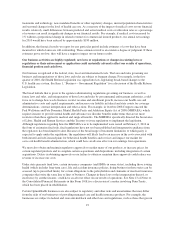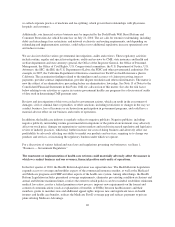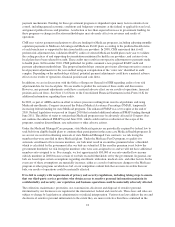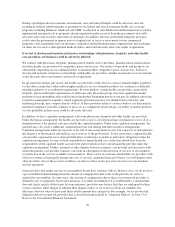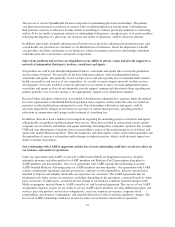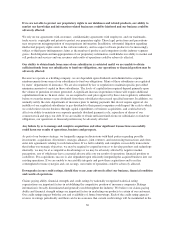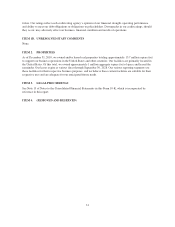United Healthcare 2010 Annual Report Download - page 23
Download and view the complete annual report
Please find page 23 of the 2010 United Healthcare annual report below. You can navigate through the pages in the report by either clicking on the pages listed below, or by using the keyword search tool below to find specific information within the annual report.Certain provisions of the Health Reform Legislation have already taken effect, and other provisions become
effective at various dates over the next several years. HHS, the DOL and the Treasury Department have issued
regulations (or proposed regulations) on a number of aspects of Health Reform Legislation, but we await final
rules and interim guidance on other key aspects of the legislation. Due to the complexity of the Health Reform
Legislation, the impact of the Health Reform Legislation remains difficult to predict and is not yet fully known.
For example, the Health Reform Legislation established minimum medical loss ratios for all commercial health
plans in the large employer group, small employer group and individual markets (85% for large employer groups,
80% for small employer groups and 80% for individuals, calculated under the definitions in the Health Reform
Legislation and regulations). Companies with medical loss ratios below these targets will be required to rebate
ratable portions of their premiums to their customers annually. Depending on the results of the calculation and
the manner in which we adjust our business model in light of this requirement, there could be meaningful
disruptions in local health care markets, and our market share, revenues and results of operations could be
materially adversely affected. In addition, the Health Reform Legislation requires the establishment of state-
based health insurance exchanges for individuals and small employers by 2014. The types of exchange
participation requirements ultimately enacted by each state, the availability of federal premium subsidies within
exchanges, the potential for differential imposition of state benefit mandates inside and outside the exchanges,
and the possibility that certain states may restrict the ability of health plans to continue to offer coverage to
individuals and small employers outside of the exchanges, could result in disruptions in local health care markets
and our revenues, financial position and results of operations could be materially adversely affected.
Several of the provisions in the Health Reform Legislation will likely increase our medical cost trends. Examples
of these provisions are the excise tax on medical devices, annual fees on prescription drug manufacturers,
enhanced coverage requirements and the prohibition of pre-existing condition exclusions. The annual insurance
industry assessment ($8 billion levied on the insurance industry in 2014 with increasing annual amounts
thereafter), which is not deductible for income tax purposes, will increase our operating costs. Premium increases
will be necessary to offset the impact these and other provisions will have on our medical and operating costs.
These premium increases are oftentimes subject to state regulatory approval, and, as required under the Health
Reform Legislation, HHS recently issued proposed rules that, if implemented, would establish a federal premium
rate review process for annual premium rate increases, generally of 10% or more. If we are not able to secure
approval for adequate premium increases to offset increases in our cost structure, our results of operations could
be materially adversely affected. In addition, plans deemed to have a history of “unreasonable” rate increases
may be prohibited from participating in the state-based exchanges that become active under the Health Reform
Legislation in 2014.
The Congressional Budget Office has estimated that up to 32 million new individuals may eventually gain
insurance coverage if the Health Reform Legislation is implemented broadly in its current form. In addition, we
expect that implementation of the Health Reform Legislation will increase the demand for products and
capabilities offered by our Health Services businesses. We have made and will continue to make strategic
decisions and investments based, in part, on these assumptions, and our results of operations or financial position
could be adversely affected if fewer individuals gain coverage under the Health Reform Legislation than
estimated or we are unable to attract these new individuals to our Health Benefits offerings, or if the demand for
our Health Services businesses does not increase.
Certain aspects of the Health Reform Legislation are also being challenged in federal court, with the proponents
of such challenges seeking to limit the scope of or have all or portions of the Health Reform Legislation declared
unconstitutional. For example, on January 31, 2011, in a case brought on behalf of 26 state attorneys general and/
or governors and certain other parties, the United States District Court for the Northern District of Florida ruled
that the provision in the Health Reform Legislation that requires individuals to purchase health insurance (or be
subject to penalties), along with the entire legislation, is unconstitutional. The United States District Court for the
Eastern District of Virginia has held that the individual mandate and certain related provisions are
unconstitutional, but without declaring the entire legislation unconstitutional. Congress may also withhold the
funding necessary to implement the Health Reform Legislation, or may attempt to replace the legislation with
21










